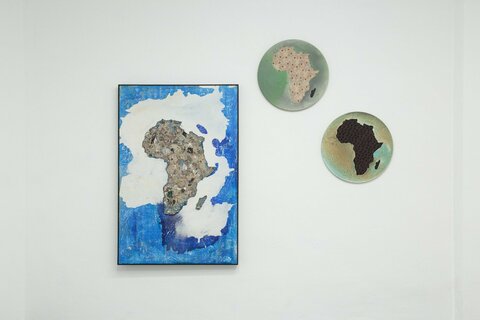


Last updated on Fri 5 February, 2021


CARTE BLANCHE À MAHI BINEBINE
NEW WORKS BY
Mahi Binebine, Nabil El Makhloufi, Najia Mehadji, Mohamed Mourabiti und Fatiha Zemmouri
Katharina Maria Raab Gallery is pleased to present the exhibition ‘Carte Blanche for Mahi Binebine. New works from Mahi Binebine, Nabil El Makhloufi, Najia Mehadji, Mohamed Mourabiti and Fatiha Zemmouri.’ In response to his carte blanche invitation, Mahi Binebine presents his work alongside that of other Moroccan artists whom he personally selected and invited: Nabil El Makhloufi, Najia Mehadji, Mohamed Mourabiti and Fatiha Zemmouri.
Loneliness and despair. Mahi Binebine presents the extremes of the human condition in his works. In his paintings, he reduces the figures to silhouettes. Their lines are interwoven; the bodies therefore inescapably connected with one another. They wrestle with one another or embrace each other in a hostile, unsettling and often confining world.
Binebine’s masks are also reduced to just a few lines, but they are extremely expressive in their simplicity. They are not masks that hide, but which reveal. They expose oppression, sorrow and suffering, but also physical pain and injury. The strength and dignity they radiate is therefore all the greater.
The people in Nabil El Makloufi’s paintings appear to us as in a dream. Detached from time and space, the people appear in groups, standing close to one another, forming a closed circle that excludes us, the observers. They seem to be waiting. Only occasionally does a person step out from the crowd or look at us silently. Their story remains vague, leaving us to guess at it. There's a sinister tension in the air. A mysterious light illuminates particular parts of the scenes.
A tondo. A silhouette of Africa. Alone, powerful, haunting. The Marrakech-based artist Mohamed Mourabiti places Africa at the centre of the world, surrounded by an ocean reproduced in natural blue and green hues. On these maps, Mourabiti shows us his view of the continent before colonisation. He presents it as it originally was, not divided into countries by borders. Mourabiti’s Africa is presented homogeneously, multicoloured and full of memories, as exemplified by the cotton garments printed with floral, botanical and geometric patterns which the artist collected on his travels in order to use them to clothe the continent with their memories.
The materials used by the artist Fatiha Zemmouri have a poetic intensity: charcoal, porcelain, fabric. The short moment of change is what interests the artist in her work with these materials. The textile works prepared for this exhibition capture this moment for eternity. The suspense as to whether, and when, the fine material will tear. Uncertainty. Time, the present, the past and the future all become clear in Zemmouri’s works. The material: completely worn out or – as if time runs backwards – still unwoven.
Gestures and movements are what fascinate Najia Mehadji. Her paintings and drawings are always created in groups, and bear titles such as ‘Volute’, ‘Arabesque’, ‘Mystical Dance’ or ‘Wave’. But in Mehadji’s work the question of figuration and abstraction remains in the background, because the white paint she uses to place these movements centrally and in stark contrast against the black background serves to increase their power, enabling us to feel their pure vitality.
Join us in our endless discovery of modern and contemporary Arab art